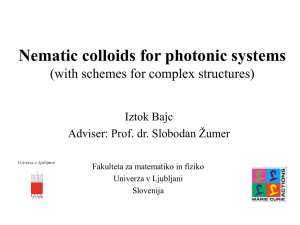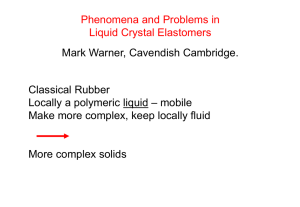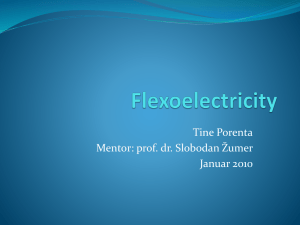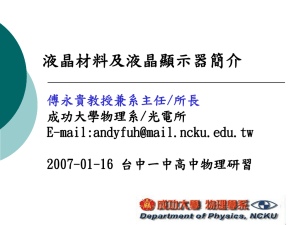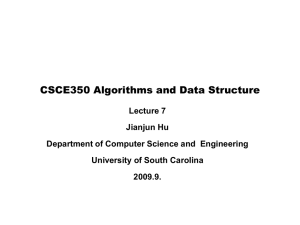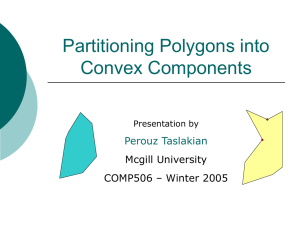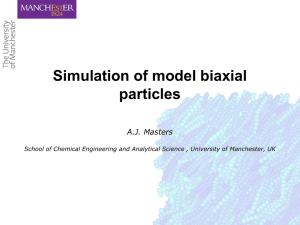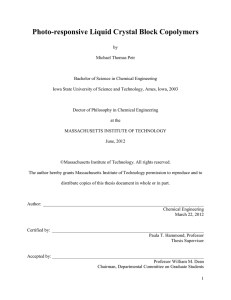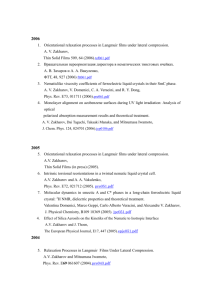MichaelDingPoster - Physics - Case Western Reserve University
advertisement
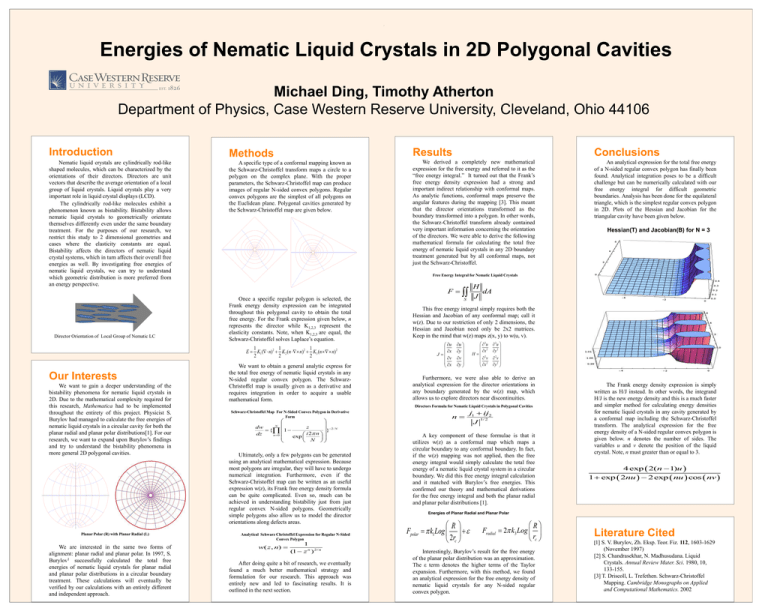
,
Energies of Nematic Liquid Crystals in 2D Polygonal Cavities
Michael Ding, Timothy Atherton
Department of Physics, Case Western Reserve University, Cleveland, Ohio 44106
Introduction
Methods
Results
Conclusions
Nematic liquid crystals are cylindrically rod-like
shaped molecules, which can be characterized by the
orientations of their directors. Directors are unit
vectors that describe the average orientation of a local
group of liquid crystals. Liquid crystals play a very
important role in liquid crystal displays (LCD).
The cylindrically rod-like molecules exhibit a
phenomenon known as bistability. Bistability allows
nematic liquid crystals to geometrically orientate
themselves differently even under the same boundary
treatment. For the purposes of our research, we
restrict this study to 2 dimensional geometries and
cases where the elasticity constants are equal.
Bistability affects the directors of nematic liquid
crystal systems, which in turn affects their overall free
energies as well. By investigating free energies of
nematic liquid crystals, we can try to understand
which geometric distribution is more preferred from
an energy perspective.
A specific type of a conformal mapping known as
the Schwarz-Christoffel transform maps a circle to a
polygon on the complex plane. With the proper
parameters, the Schwarz-Christoffel map can produce
images of regular N-sided convex polygons. Regular
convex polygons are the simplest of all polygons on
the Euclidean plane. Polygonal cavities generated by
the Schwarz-Christoffel map are given below.
We derived a completely new mathematical
expression for the free energy and referred to it as the
“free energy integral.” It turned out that the Frank’s
free energy density expression had a strong and
important indirect relationship with conformal maps.
As analytic functions, conformal maps preserve the
angular features during the mapping [3]. This meant
that the director orientations transformed as the
boundary transformed into a polygon. In other words,
the Schwarz-Christoffel transform already contained
very important information concerning the orientation
of the directors. We were able to derive the following
mathematical formula for calculating the total free
energy of nematic liquid crystals in any 2D boundary
treatment generated but by all conformal maps, not
just the Schwarz-Christoffel.
An analytical expression for the total free energy
of a N-sided regular convex polygon has finally been
found. Analytical integration poses to be a difficult
challenge but can be numerically calculated with our
free energy integral for difficult geometric
boundaries. Analysis has been done for the equilateral
triangle, which is the simplest regular convex polygon
in 2D. Plots of the Hessian and Jacobian for the
triangular cavity have been given below.
Director Orientation of Local Group of Nematic LC
Free Energy Integral for Nematic Liquid Crystals
Once a specific regular polygon is selected, the
Frank energy density expression can be integrated
throughout this polygonal cavity to obtain the total
free energy. For the Frank expression given below, n
represents the director while K1,2,3 represent the
elasticity constants. Note, when K1,2,3 are equal, the
Schwarz-Christoffel solves Laplace’s equation.
1
1
1
E K1 ( n)2 K 2 (n n)2 K 3 (n n)2
2
2
2
Our Interests
We want to gain a deeper understanding of the
bistability phenomena for nematic liquid crystals in
2D. Due to the mathematical complexity required for
this research, Mathematica had to be implemented
throughout the entirety of this project. Physicist S.
Burylov had managed to calculate the free energies of
nematic liquid crystals in a circular cavity for both the
planar radial and planar polar distributions[1]. For our
research, we want to expand upon Burylov’s findings
and try to understand the bistability phenomena in
more general 2D polygonal cavities.
Planar Polar (R) with Planar Radial (L)
We are interested in the same two forms of
alignment: planar radial and planar polar. In 1997, S.
Burylov1 successfully calculated the total free
energies of nematic liquid crystals for planar radial
and planar polar distributions in a circular boundary
treatment. These calculations will eventually be
verified by our calculations with an entirely different
and independent approach.
Hessian(T) and Jacobian(B) for N = 3
We want to obtain a general analytic express for
the total free energy of nematic liquid crystals in any
N-sided regular convex polygon. The SchwarzChristoffel map is usually given as a derivative and
requires integration in order to acquire a usable
mathematical form.
F
S
H
J
dA
This free energy integral simply requires both the
Hessian and Jacobian of any conformal map; call it
w(z). Due to our restriction of only 2 dimensions, the
Hessian and Jacobian need only be 2x2 matrices.
Keep in the mind that w(z) maps z(x, y) to w(u, v).
u
x
J
v
x
u
y
v
y
2u
2
x
H 2
v
2
x
2u
y 2
2v
y 2
Furthermore, we were also able to derive an
analytical expression for the director orientations in
any boundary generated by the w(z) map, which
allows us to explore directors near discontinuities.
Directors Formula for Nematic Liquid Crystals in Polygonal Cavities
Schwarz-Christoffel Map For N-Sided Convex Polygon in Derivative
Form
N
dw
z
}2/ N
{ 1
dz
i 2 n
n 0
exp
N
Ultimately, only a few polygons can be generated
using an analytical mathematical expression. Because
most polygons are irregular, they will have to undergo
numerical integration. Furthermore, even if the
Schwarz-Christoffel map can be written as an useful
expression w(z), its Frank free energy density formula
can be quite complicated. Even so, much can be
achieved in understanding bistability just from just
regular convex N-sided polygons. Geometrically
simple polygons also allow us to model the director
orientations along defects areas.
Analytical Schwarz Christoffel Expression for Regular N-Sided
Convex Polygon
1
w( z , n)
(1 z n ) 2/ n
After doing quite a bit of research, we eventually
found a much better mathematical strategy and
formulation for our research. This approach was
entirely new and led to fascinating results. It is
outlined in the next section.
n
j1 ij2
J
1/ 2
A key component of these formulae is that it
utilizes w(z) as a conformal map which maps a
circular boundary to any conformal boundary. In fact,
if the w(z) mapping was not applied, then the free
energy integral would simply calculate the total free
energy of a nematic liquid crystal system in a circular
boundary. We did this free energy integral calculation
and it matched with Burylov’s free energies. This
confirmed our theory and mathematical derivations
for the free energy integral and both the planar radial
and planar polar distributions [1].
The Frank energy density expression is simply
written as H/J instead. In other words, the integrand
H/J is the new energy density and this is a much faster
and simpler method for calculating energy densities
for nematic liquid crystals in any cavity generated by
a conformal map including the Schwarz-Christoffel
transform. The analytical expression for the free
energy density of a N-sided regular convex polygon is
given below. n denotes the number of sides. The
variables u and v denote the position of the liquid
crystal. Note, n must greater than or equal to 3.
4 exp 2(n 1)u
1 exp 2nu 2 exp nu cos nv
Energies of Planar Radial and Planar Polar
R
Fpolar k1Log
2rc
Fradial
R
2 k3 Log
rc
Interestingly, Burylov’s result for the free energy
of the planar polar distribution was an approximation.
The ε term denotes the higher terms of the Taylor
expansion. Furthermore, with this method, we found
an analytical expression for the free energy density of
nematic liquid crystals for any N-sided regular
convex polygon.
Literature Cited
[1] S. V. Burylov, Zh. Eksp. Teor. Fiz. 112, 1603-1629
(November 1997)
[2] S. Chandrasekhar, N. Madhusudana. Liquid
Crystals. Annual Review Mater. Sci. 1980, 10,
133-155.
[3] T. Driscoll, L. Trefethen. Schwarz-Christoffel
Mapping. Cambridge Monographs on Applied
and Computational Mathematics. 2002

